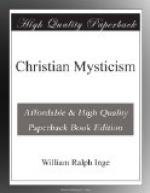There are many, I fear, to whom “the mystical element in the Old Testament” will suggest only the Cabbalistic lore of types and allegories which has been applied to all the canonical books, and with especial persistency and boldness to the Song of Solomon. I shall give my opinion upon this class of allegorism in the seventh Lecture of this course, which will deal with symbolism as a branch of Mysticism. It would be impossible to treat of it here without anticipating my discussion of a principle which has a much wider bearing than as a method of biblical exegesis. As to the Song of Solomon, its influence upon Christian Mysticism has been simply deplorable. A graceful romance in honour of true love was distorted into a precedent and sanction for giving way to hysterical emotions, in which sexual imagery was freely used to symbolise the relation between the soul and its Lord. Such aberrations are as alien to sane Mysticism as they are to sane exegesis.[59]
In Jewish writings of a later period, composed under Greek influence, we find plenty of Platonism ready to pass into Mysticism. But the Wisdom of Solomon does not fall within our subject, and what is necessary to be said about Philo and Alexandria will be said in the next Lecture. In the New Testament, it will be convenient to say a very few words on the Synoptic Gospels first, and afterwards to consider St. John and St. Paul, where we shall find most of our material.
The first three Gospels are not written in the religious dialect of Mysticism. It is all the more important to notice that the fundamental doctrines on which the system (if we may call it a system) rests, are all found in them. The vision of God is promised in the Sermon on the Mount, and promised only to those who are pure in heart. The indwelling presence of Christ, or of the Holy Spirit, is taught in several places; for instance—“The kingdom of God is within you”; “Where two or three are gathered together in My name, there am I in the midst of them”; “Lo, I am with you alway, even to the end of the world.” The unity of Christ and His members is implied by the words, “Inasmuch as ye have done it to one of the least of these My brethren, ye have done it unto Me.” Lastly, the great law of the moral world,—the law of gain through loss, of life through death,—which is the corner-stone of mystical (and, many have said, of Christian) ethics, is found in the Synoptists as well as in St. John. “Whosoever shall seek to gain his life (or soul) shall lose it; but whosoever shall lose his life (or soul) shall preserve it.”




